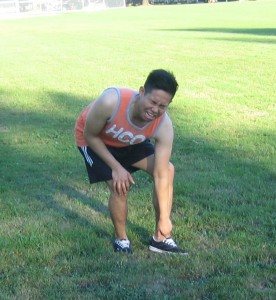An ankle sprain is a condition where the ankles become swollen and painful after being twisted, this happens due to the ligaments being stretched or torn in the ankles. While ankle sprains are prevalent, they are not considered to be minor injuries as they can lead to lasting joint pain and weakness if there are occurrences of repeated ankle sprains.
Most ankle sprains occur while playing sports such as soccer or football as sudden movements to the knees may occur.
Signs and symptoms of an ankle sprain:
- Pain in the injured leg, especially while trying to move.
- Bruising in the injured leg.
- Difficulty or inability on putting weight on the injured leg.
- Discoloration of the skin.

Pain in the injured leg, especially while trying to move.
To assess the severity of the injury, your doctor will perform numerous tests and exams on the ankle to see how much your ankle can move. Your doctor will also perform an x-ray scan to see if any bone damages are present. MRI scans may also be performed to see how many ligaments were damaged.
Treatments for an ankle sprain:
- Follow the RICE approach,
- Rest, in which you should stop all activity and sit down.
- Ice, in which for the first twenty-four (24) hours to seventy-two (72) hours or until the swelling stops, apply an ice pack on the injured area at least two (2) times a day.
- Compression, wrap the injured area with a bandage with elastic compression to help reduce swelling for the first twenty-four (24) to thirty-six (36) hours.
- Elevation, raise the injured ankle to the level above the heart for at least two (2) to three (3) hours a day to help reduce swelling.
- Crutches, if required to help maneuver.
- Taking over-the-counter pain medication such as ibuprofen or acetaminophen.
- Keep your foot elevated, have it rested on a pillow to reduce swelling and don’t put weight on your ankle.
- Get plenty of rest.
In rare cases, surgery may be required to repair the damages caused by the ankle sprain. This is only needed if the injury doesn’t heal or improve after being treated with nonsurgical treatments.
- Arthroscopy, where the surgeon inspects the joint for any traces of loose fragments of bone or cartilage.
- Reconstruction, where the surgeon repairs the torn ligaments through stitches.
Common methods to prevent an ankle sprain:
- Doing warmups before exercising.
- Perform exercises that strengthen the legs.
- Avoid high heels.
- Wear good quality footwear that is sturdy.
- Slow down or stop the strenuous activity you are doing when you feel fatigue.
If you’ve sprained your ankle again, seek medical attention as this may lead to long-term pain and instability if left untreated.
Disclaimer / More Information
The material posted on this page on an ankle sprain is for learning purposes only. Learn to recognize the signs and how it is treated by taking a first aid and CPR class with one of our training providers.
